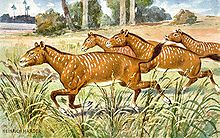- Mesohippus
-
Mesohippus
Temporal range: Early Oligocene
Mesohippus Scientific classification Kingdom: Animalia Phylum: Chordata Class: Mammalia Order: Perissodactyla Family: Equidae Subfamily: †Anchitheriinae Genus: Mesohippus
Marsh, 1875Species M. bairdi
M. barbouri
M. braquistylus
M. equiceps
M. hypostylus
M. intermedius
M. latidens
M. longiceps
M. metulophus
M. montanensis
M. obliquidens
M. proteulophus
M. westoniMesohippus (Greek: μεσο/meso meaning "middle" and ιππος/hippos meaning "horse") is an extinct genus of early horse. It lived some 40 to 30 million years ago from the late Eocene to the mid-Oligocene. Like many fossil horses, Mesohippus was common in North America.
Contents
Description
Mesohippus had longer legs than its predecessor Hyracotherium and stood about 60 cm {6 hands} tall. It had also lost a toe and stood predominantly on its middle toe, although the other two were also used.[1] The face of Mesohippus was longer and larger than earlier equids. It had a slight facial fossa, or depression, in the skull. The eyes were rounder, and were set wider apart and farther back than in Hyracotherium.
Unlike earlier horses, its teeth contained a single gap behind the front teeth, where the bit now rests in the modern horse. In addition, it had another grinding tooth, making a total of six. Mesohippus was a browser that fed on tender twigs and fruit.[1] The cerebral hemisphere, or cranial cavity, was notably larger than that of its predecessors; its brain was similar to that of modern horses.
See also
References
External links

This horse-related article is a stub. You can help Wikipedia by expanding it.


